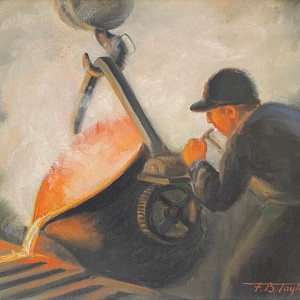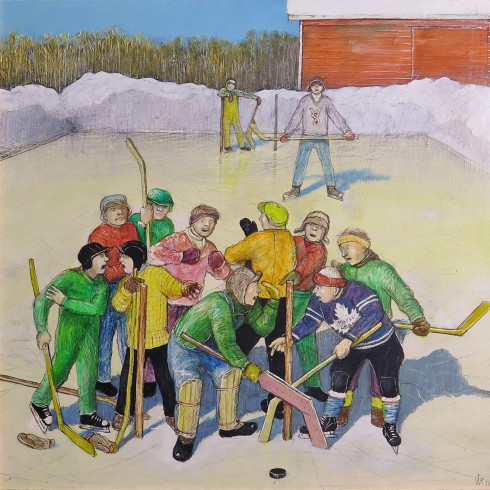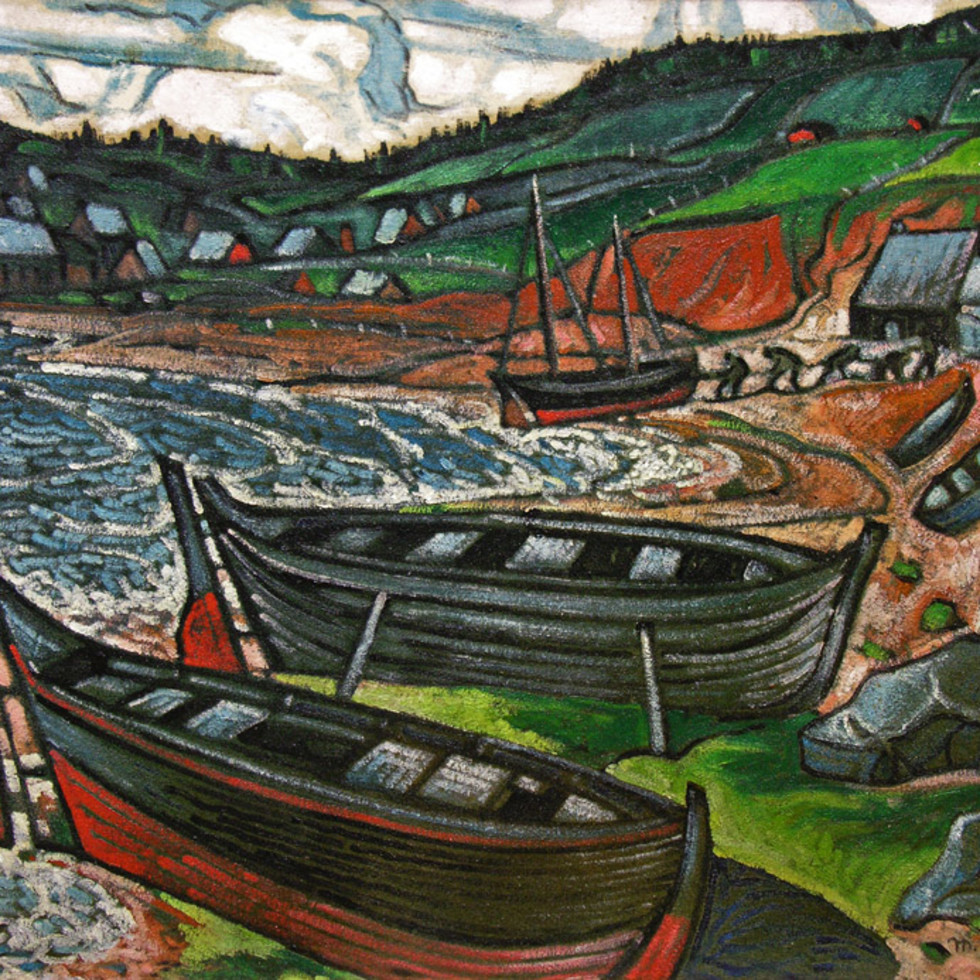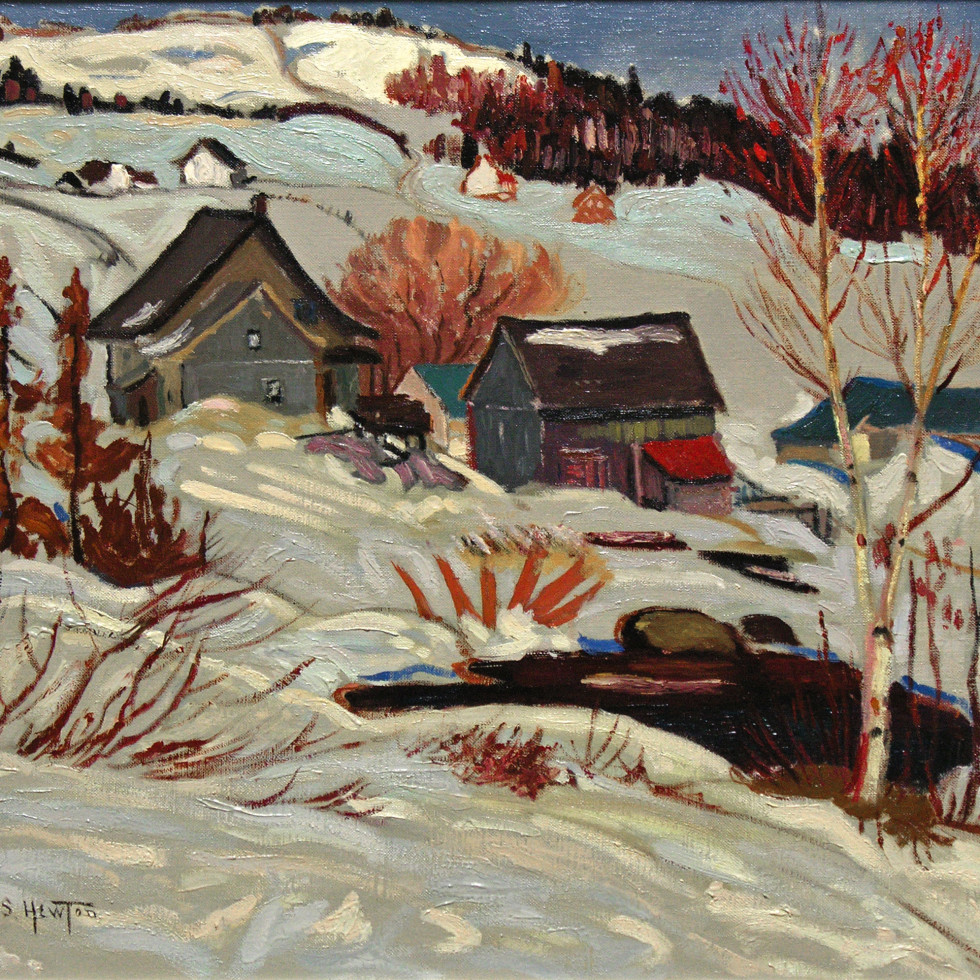Pouring Residue Bronze into the Chill Moulds [for bronze parts Anti Aircraft Guns] in the Brass Foundry, Dominion Engineering Works, Lachine, Quebec, 1942 (November 5)
33 x 40.6 cm
Inscriptions
signed and dated, ‘F.B Taylor ‘42’ (lower right); titled and dated by the artist, ‘POURING RESIDUE BRONZE INTO CHILL MOULDS/IN THE BRASS FOUNDRY. NOVEMBER 1942/DOMINION ENGINEERING WORKS LACHINE. P.Q’(verso, upper horizontal stretcher, left) and inscribed ‘FREDERICK B. TAYLOR/3633 OXENDEN AVENUE/MONTREAL P.Q.’ (verso, upper horizontal stretcher, right)Provenance
Private collection, Montreal;
Private collection, Montreal, daughter of the above;
Alan Klinkhoff Gallery, October 21 2015;
Private collection, Toronto, November 13, 2015;
Mayberry Fine Art;
Alan Klinkhoff Gallery.
Exhibitions
Montreal, Galerie Alan Klinkhoff, Montreal, Artists in the City of Montreal, January 2015;
Toronto, Alan Klinkhoff Gallery, Toronto, The Beaver Hall Group & The Klinkhoff Family, March 2016.
While the Canadian government had sent artists overseas as War Artists there was no programme to encourage artists at home. In 1996, Sophie Gironnay’s Frederick B. Taylor, Graveur réaliste radical, she underlines that while Canada’s contribution to the war effort was most certainly the military support in personnel but also through the unprecedented industrial expansion building tanks, ships, guns, aircraft and armaments of various kinds. Taylor was a pioneer, entering the factories to paint and thereby celebrate Canadian workers, male and female who were to support the war effort.
From 1942 until 1945, Taylor sketched at The Fairchild Aircraft Plant in Longueuil where Boilingbroke Bombers were being built, the Dominion Engineering Works plant in Lachine where “pom pom guns” were being produced for corvettes and other plants where Canadian workers were providing armaments for the war effort. The work produced by Taylor in the city of Montreal, in his own words, “emphasises the immense historical importance of the war and war-time production in Canada” and were a testament to the period of time in which “Canada grew from an industrial nation of small importance to one of truly great importance" (Autobiographical notes, p.34). In addition to having documented the wartime effort, Taylor’s social-realist portraits also served to encourage the labour movement in Quebec.
Barry Lord’s The History of Painting in Canada: Toward a People’s Art and the autobiographical notes of the artist himself provide important insight as to their importance. According to Lord, “Taylor wanted to go into the factories that were producing armaments and other war materials, and paint the heroic portraits of workers with outstanding production records, as well as pictures of highly productive work teams in action. These he suggested could be used as posters and otherwise exhibited in factories and union halls to encourage an all-out effort to increase war production to defeat fascism”. [1]
Pouring Residue Bronze into Chill Moulds in the Brass Foundry, Dominion Engineering Works, Lachine, 1942 is a fine example of this important body of work, championing the working class and their contributions to Canada’s achievements in World War II.
_________________________________
Footnotes:
1. Barry Lord. The History of Painting in Canada : Toward a people’s art, (Toronto: NC Press, 1974), 195




![Pouring Residue Bronze into the Chill Moulds [for bronze parts Anti Aircraft Guns] in the Brass Foundry, Dominion Engineering Works, Lachine, Quebec](https://artlogic-res.cloudinary.com/w_2000,h_2000,c_limit,f_auto,fl_lossy,q_40/artlogicstorage/alanklinkhoff/images/view/22c8182f14847c1bca1e066d26d8e439j/alanklinkhoffgallery-artdealers-appraisers-frederick-b.-taylor-pouring-residue-bronze-into-the-chill-moulds-for-bronze-parts-anti-aircraft-guns-in-the-brass-foundry-dominion-engi.jpg)
![Pouring Residue Bronze into the Chill Moulds [for bronze parts Anti Aircraft Guns] in the Brass Foundry, Dominion Engineering Works, Lachine, Quebec](https://artlogic-res.cloudinary.com/w_2000,h_2000,c_limit,f_auto,fl_lossy,q_40/artlogicstorage/alanklinkhoff/images/view/95af4d5215c37795c33482c89db8cac6j/alanklinkhoffgallery-artdealers-appraisers-frederick-b.-taylor-pouring-residue-bronze-into-the-chill-moulds-for-bronze-parts-anti-aircraft-guns-in-the-brass-foundry-dominion-engi.jpg)
![Pouring Residue Bronze into the Chill Moulds [for bronze parts Anti Aircraft Guns] in the Brass Foundry, Dominion Engineering Works, Lachine, Quebec](https://artlogic-res.cloudinary.com/w_2000,h_2000,c_limit,f_auto,fl_lossy,q_40/artlogicstorage/alanklinkhoff/images/view/e4b83b57df9ffae4307592e32beddb51j/alanklinkhoffgallery-artdealers-appraisers-frederick-b.-taylor-pouring-residue-bronze-into-the-chill-moulds-for-bronze-parts-anti-aircraft-guns-in-the-brass-foundry-dominion-engi.jpg)
![Pouring Residue Bronze into the Chill Moulds [for bronze parts Anti Aircraft Guns] in the Brass Foundry, Dominion Engineering Works, Lachine, Quebec](https://artlogic-res.cloudinary.com/w_2000,h_2000,c_limit,f_auto,fl_lossy,q_40/artlogicstorage/alanklinkhoff/images/view/5e1253ad6fbddfb081c9a3ceb8b3b0e1j/alanklinkhoffgallery-artdealers-appraisers-frederick-b.-taylor-pouring-residue-bronze-into-the-chill-moulds-for-bronze-parts-anti-aircraft-guns-in-the-brass-foundry-dominion-engi.jpg)












